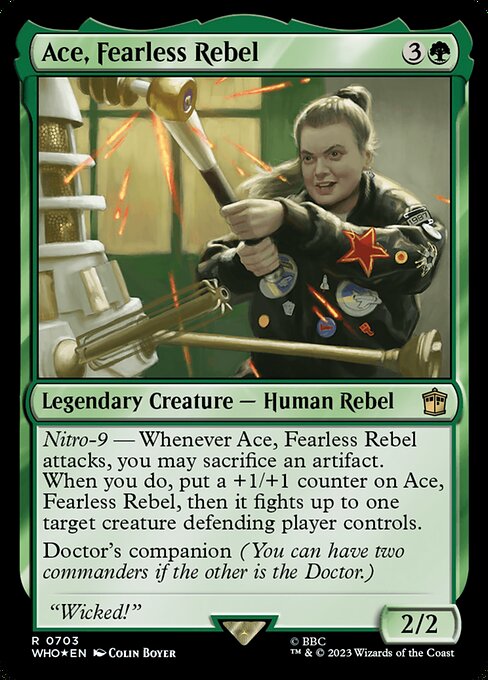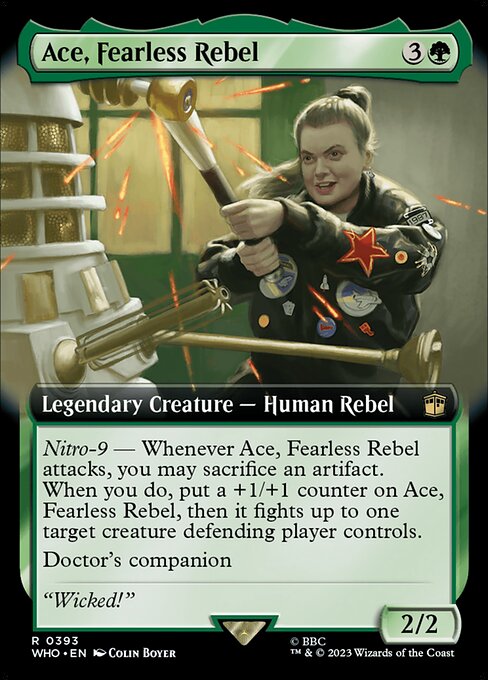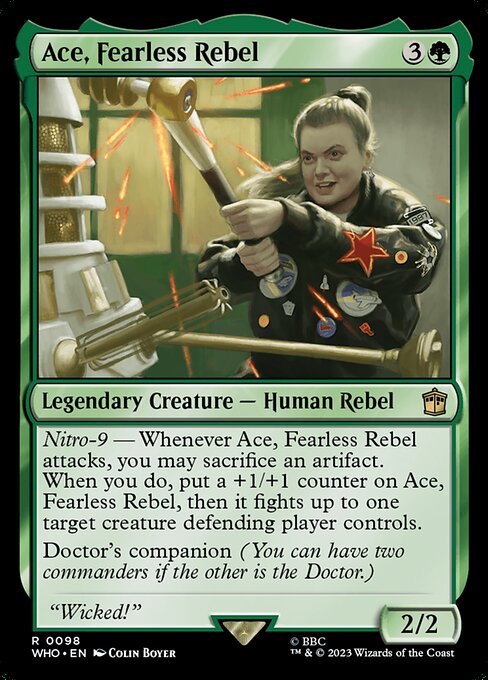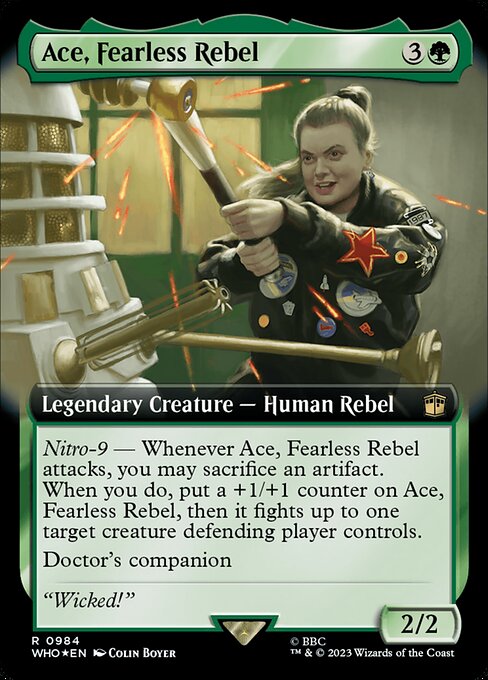Ace, Fearless Rebel
Legendary Creature — Human Rebel
Nitro-9 — Whenever Ace, Fearless Rebel attacks, you may sacrifice an artifact. When you do, put a +1/+1 counter on Ace, Fearless Rebel, then it fights up to one target creature defending player controls.
Doctor's companion (You can have two commanders if the other is the Doctor.)
Doctor's companion (You can have two commanders if the other is the Doctor.)
2/2
standard
future
historic
gladiator
pioneer
explorer
modern
legacy
pauper
vintage
penny
commander
brawl
alchemy
paupercommander
duel
oldschool
premodern
Rulings
Although Doctor's companion is a new variant of the partner ability, the rules for partner have not otherwise changed. Notably, Time Lord Doctors and cards with Doctor's companion do not interact with cards which have another partner ability.
Both commanders start in the command zone, and the remaining 98 cards (or 58 cards in a Commander Draft game) of your deck are shuffled to become your library.
If something refers to your commander while you have two commanders, it refers to one of them of your choice. If you are instructed to perform an action on your commander (e.g. put it from the command zone into your hand due to Command Beacon), you choose one of your commanders at the time the effect happens.
Once the game begins, your two commanders are tracked separately. If you cast one, you won't have to pay an additional the first time you cast the other. A player loses the game after having been dealt 21 combat damage from any one of them, not from both of them combined.
The Doctor's companion ability allows you to have two commanders if one has the ability and the other is a legendary creature that is a Time Lord Doctor and has no other creature types. Creatures with the changeling ability, for example, can't be a second commander this way.
If your Commander deck has two commanders, you can include only cards whose own color identities are also found in your commanders' combined color identities.
If you choose no target for Ace's Nitro-9 ability, you will put a +1/+1 counter on it. However, if you choose a target and it is an illegal target as the ability tries to resolve, you won't put a +1/+1 counter on Ace. In either case, no fight will happen and no creature will deal or be dealt damage.
An effect that checks whether you control your commander is satisfied if you control one or both of your two commanders.
Both commanders start in the command zone, and the remaining 98 cards (or 58 cards in a Commander Draft game) of your deck are shuffled to become your library.
If something refers to your commander while you have two commanders, it refers to one of them of your choice. If you are instructed to perform an action on your commander (e.g. put it from the command zone into your hand due to Command Beacon), you choose one of your commanders at the time the effect happens.
Once the game begins, your two commanders are tracked separately. If you cast one, you won't have to pay an additional the first time you cast the other. A player loses the game after having been dealt 21 combat damage from any one of them, not from both of them combined.
The Doctor's companion ability allows you to have two commanders if one has the ability and the other is a legendary creature that is a Time Lord Doctor and has no other creature types. Creatures with the changeling ability, for example, can't be a second commander this way.
If your Commander deck has two commanders, you can include only cards whose own color identities are also found in your commanders' combined color identities.
If you choose no target for Ace's Nitro-9 ability, you will put a +1/+1 counter on it. However, if you choose a target and it is an illegal target as the ability tries to resolve, you won't put a +1/+1 counter on Ace. In either case, no fight will happen and no creature will deal or be dealt damage.
An effect that checks whether you control your commander is satisfied if you control one or both of your two commanders.
Rulings
Although Doctor's companion is a new variant of the partner ability, the rules for partner have not otherwise changed. Notably, Time Lord Doctors and cards with Doctor's companion do not interact with cards which have another partner ability.
Both commanders start in the command zone, and the remaining 98 cards (or 58 cards in a Commander Draft game) of your deck are shuffled to become your library.
If something refers to your commander while you have two commanders, it refers to one of them of your choice. If you are instructed to perform an action on your commander (e.g. put it from the command zone into your hand due to Command Beacon), you choose one of your commanders at the time the effect happens.
Once the game begins, your two commanders are tracked separately. If you cast one, you won't have to pay an additional the first time you cast the other. A player loses the game after having been dealt 21 combat damage from any one of them, not from both of them combined.
The Doctor's companion ability allows you to have two commanders if one has the ability and the other is a legendary creature that is a Time Lord Doctor and has no other creature types. Creatures with the changeling ability, for example, can't be a second commander this way.
If your Commander deck has two commanders, you can include only cards whose own color identities are also found in your commanders' combined color identities.
If you choose no target for Ace's Nitro-9 ability, you will put a +1/+1 counter on it. However, if you choose a target and it is an illegal target as the ability tries to resolve, you won't put a +1/+1 counter on Ace. In either case, no fight will happen and no creature will deal or be dealt damage.
An effect that checks whether you control your commander is satisfied if you control one or both of your two commanders.
Both commanders start in the command zone, and the remaining 98 cards (or 58 cards in a Commander Draft game) of your deck are shuffled to become your library.
If something refers to your commander while you have two commanders, it refers to one of them of your choice. If you are instructed to perform an action on your commander (e.g. put it from the command zone into your hand due to Command Beacon), you choose one of your commanders at the time the effect happens.
Once the game begins, your two commanders are tracked separately. If you cast one, you won't have to pay an additional the first time you cast the other. A player loses the game after having been dealt 21 combat damage from any one of them, not from both of them combined.
The Doctor's companion ability allows you to have two commanders if one has the ability and the other is a legendary creature that is a Time Lord Doctor and has no other creature types. Creatures with the changeling ability, for example, can't be a second commander this way.
If your Commander deck has two commanders, you can include only cards whose own color identities are also found in your commanders' combined color identities.
If you choose no target for Ace's Nitro-9 ability, you will put a +1/+1 counter on it. However, if you choose a target and it is an illegal target as the ability tries to resolve, you won't put a +1/+1 counter on Ace. In either case, no fight will happen and no creature will deal or be dealt damage.
An effect that checks whether you control your commander is satisfied if you control one or both of your two commanders.
Your collection? Your decks?
Want to manage your collection and/or create decks?



 0
0
 0.20€
0.20€

